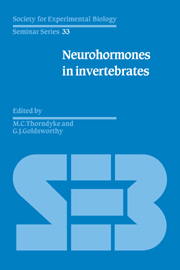Book contents
- Frontmatter
- Contents
- List of contributors
- Preface
- What is special about peptides as neuronal messengers?
- Part I Immunocytochemistry and Ultrastructure
- Part II Arthropod Neurohormones
- Part III Neurohormones in Coelenterates, Annelids and Protochordates
- Part IV Neurohormones in Molluscs
- Bioactive peptides in molluscs
- Actions and roles of the FMRFamide peptides in Helix
- Evolution of peptide hormones: an Aplysia CRF-like peptide
- Index
Bioactive peptides in molluscs
Published online by Cambridge University Press: 04 August 2010
- Frontmatter
- Contents
- List of contributors
- Preface
- What is special about peptides as neuronal messengers?
- Part I Immunocytochemistry and Ultrastructure
- Part II Arthropod Neurohormones
- Part III Neurohormones in Coelenterates, Annelids and Protochordates
- Part IV Neurohormones in Molluscs
- Bioactive peptides in molluscs
- Actions and roles of the FMRFamide peptides in Helix
- Evolution of peptide hormones: an Aplysia CRF-like peptide
- Index
Summary
Introduction
In molluscs, bioactive peptides are produced by peptidergic neurons, endocrine glands and other tissues, such as cells of the intestinal tract. These peptides function as neurotransmitters/neuromodulators and (neuro)hormones, and control a wide range of events concerned with behaviour, reproduction, and metabolism. Particular attention has been paid to the peptidergic model systems in Lymnaea and Aplysia, to FMRFamide and related peptides which also exhibit an extra-molluscan distribution, and to the presence and function of vertebrate peptides in molluscs.
Our knowledge of biologically active peptides in molluscs is expanding rapidly due to the introduction, among other things, of sophisticated chromatographic and sequence techniques, and the methods of molecular biology. A review of this length must, of necessity, be selective. We have attempted to give a critical account of the data concerning the physiological role and the nature of (presumed) bioactive peptides, and avoided discussions of non-relevant details. Recent reviews present a wealth of complementary data (e.g. Joosse & Geraerts 1983; Geraerts & Joosse 1984; Roubos 1984; Rothman et al 1985; Geraerts et al. 1987. See also Chapters 2 and 14 this volume).
The FMRFamide family, and opioid peptides
The FMRFamide family
The neuropeptide FMRFamide was isolated originally from the clam Macrocallista nimbosa (Price & Greenberg 1977). In addition to FMRFamide, various related peptides have subsequently been isolated from the brain of a number of species belonging to different classes of the molluscs (Table 1).
- Type
- Chapter
- Information
- Neurohormones in Invertebrates , pp. 261 - 282Publisher: Cambridge University PressPrint publication year: 1988
- 8
- Cited by



